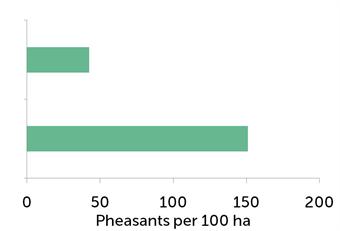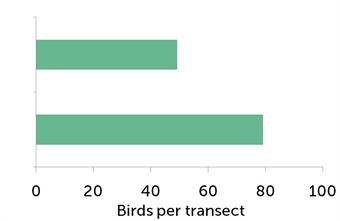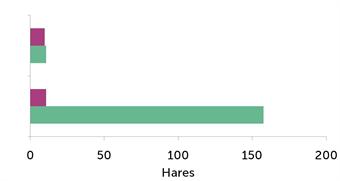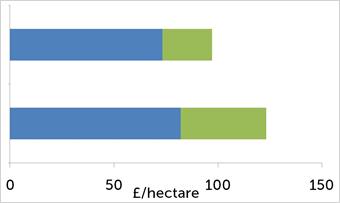The Allerton Project
The Allerton Project was set up in 1992 as a mixed arable and livestock business on 333 hectares of clay soil. Crops are primarily winter wheat and oats (sold as ‘Conservation Grade’), oilseed rape and spring beans, with 280 sheep grazing. The farm is a conservation demonstration. Accounts, including conservation costs, are published in the annual review of the Game and Wildlife Conservation Trust.
Game Management and Wildlife Conservation

Number of Common Pheasant per 100 hectares in the autumn before management (top) and with habitat management plus gamekeeping (bottom).
After a baseline year in which initial game and wildlife abundance was assessed, habitats to provide nesting cover, insect food for chicks, and food and cover in winter were all increased. Nest predators were controlled and grain provided to feed game in winter, but there was no releasing of reared game. The combined effect on wild pheasants, songbirds and hares was dramatic.
Woodland Management
Allerton woods are managed to ensure that trees, shrubs and herbs co-exist to benefit many wildlife species. Woodland also provides fuel for a fully automated wood-chip burner to heat the main building, thus giving economic benefit and reducing carbon emissions. Some funds are available through Woodland Grants Schemes to support this management as well. Damage by introduced muntjac deer to rare woodland plants is assessed, working with local people to address this problem.

Number of songbirds (species in the UK Biodiversity Action Plan) per study transect before management (top) and with habitat management plus gamekeeping (bottom).
Environmental Stewardship
Allerton shows that habitats developed for game also benefit other wildlife species:
• A combination of seed species planted for game gives songbirds abundant food in winter.
• Beetle banks protect through winter the insects that eat crop pests (e.g. greenfly), which reduces the need for summer insecticides and hence increases the quantity of other insect-food for young birds; they also make ideal nest sites for harvest mice and other small mammals, as well as grey partridges.
• Conservation headlands are crop edges where selective spraying lets low densities of non-competitive weeds survive; this supports insects as essential food for gamebird and songbird chicks and can also help preserve rare arable plants.

Hares recorded at Loddington (green) and a local comparison site (red) before management (top) and with habitat-management plus gamekeeping (bottom).
• Grass field boundaries support beneficial insects and are nest sites for birds (e.g. yellowhammers), while protecting hedges and ditches from spray drift and surface run-off from arable land; they can also be buffer strips for reducing soil and nutrient loss to water.
• These measures combine with minimum tillage to reduce soil erosion and diffuse pollution for River Basin Management Plans under the Water Framework Directive; minimum tillage can reduce loss of phosphorus and nitrogen, and give higher levels of soil fungi and earthworms to improve the soil.
Economics at Allerton

Income (top bar) and costs (bottom bar) of stewardship grants versus costs of habitat work (in blue) and shooting revenues versus gamekeeper and food costs (in green).
These measures produce costs for productive farming, but also produce benefits to offset those costs. The increase in game enabled up to five shoots and dog field trials to be held each winter and provided some income to offset the costs of management and a gamekeeper. Although shooting does not fully compensate costs of game keeping, it provides employment and a social focus within the local community.
On the Web
Portable Summary Documents for Field Operators